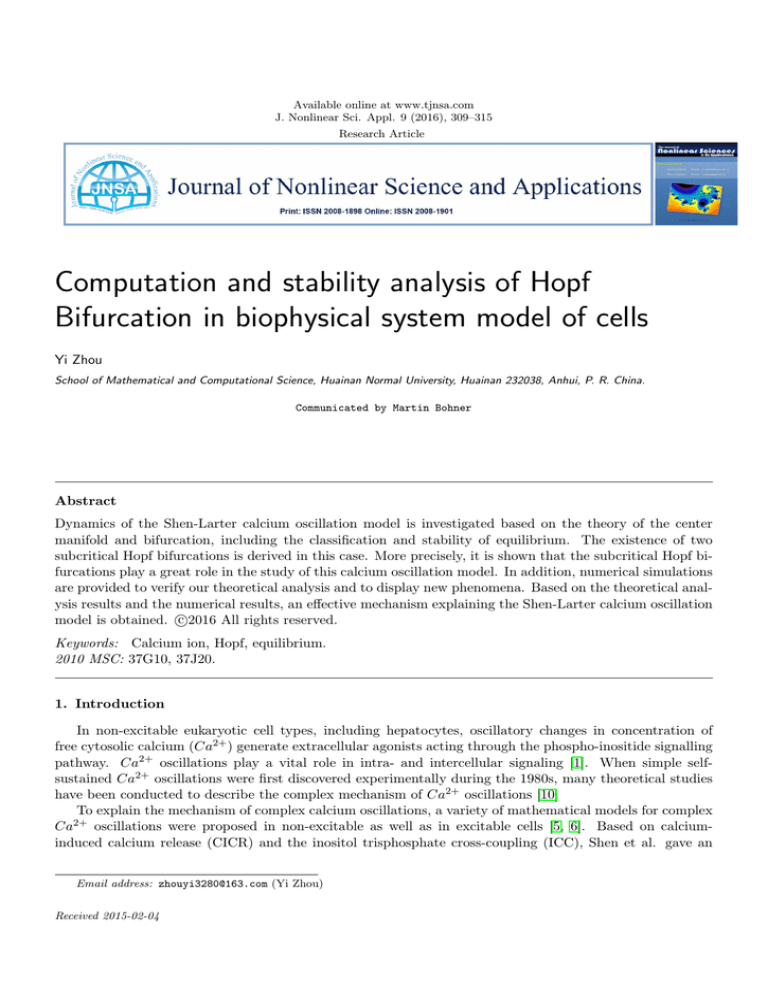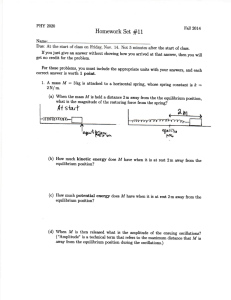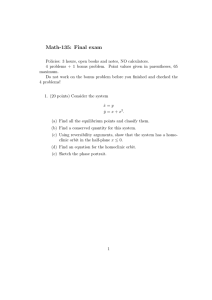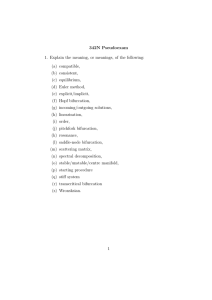
Available online at www.tjnsa.com
J. Nonlinear Sci. Appl. 9 (2016), 309–315
Research Article
Computation and stability analysis of Hopf
Bifurcation in biophysical system model of cells
Yi Zhou
School of Mathematical and Computational Science, Huainan Normal University, Huainan 232038, Anhui, P. R. China.
Communicated by Martin Bohner
Abstract
Dynamics of the Shen-Larter calcium oscillation model is investigated based on the theory of the center
manifold and bifurcation, including the classification and stability of equilibrium. The existence of two
subcritical Hopf bifurcations is derived in this case. More precisely, it is shown that the subcritical Hopf bifurcations play a great role in the study of this calcium oscillation model. In addition, numerical simulations
are provided to verify our theoretical analysis and to display new phenomena. Based on the theoretical analysis results and the numerical results, an effective mechanism explaining the Shen-Larter calcium oscillation
c
model is obtained. 2016
All rights reserved.
Keywords: Calcium ion, Hopf, equilibrium.
2010 MSC: 37G10, 37J20.
1. Introduction
In non-excitable eukaryotic cell types, including hepatocytes, oscillatory changes in concentration of
free cytosolic calcium (Ca2+ ) generate extracellular agonists acting through the phospho-inositide signalling
pathway. Ca2+ oscillations play a vital role in intra- and intercellular signaling [1]. When simple selfsustained Ca2+ oscillations were first discovered experimentally during the 1980s, many theoretical studies
have been conducted to describe the complex mechanism of Ca2+ oscillations [10]
To explain the mechanism of complex calcium oscillations, a variety of mathematical models for complex
Ca2+ oscillations were proposed in non-excitable as well as in excitable cells [5, 6]. Based on calciuminduced calcium release (CICR) and the inositol trisphosphate cross-coupling (ICC), Shen et al. gave an
Email address: zhouyi3280@163.com (Yi Zhou)
Received 2015-02-04
Y. Zhou, J. Nonlinear Sci. Appl. 9 (2016), 309–315
310
early theoretical study of complex Ca2+ oscillations trying to describe bursting Ca2+ oscillations in nonexcitable cells [11]. A more detailed study of different mechanisms explaining the Ca2+ oscillations in
non-excitable cells have been given by Borghans [2] and further mathematically analyzed by Houart, et al.
[3, 4, 7, 12]. Synchronization behaviors of non-excitable cells by gap junction coupling were explored by
Huo and Zhou, and the threshold values of synchronization for identical and un-identical oscillators were
computed numerically [8].
The mathematical models for Ca2+ oscillations in non-excitable cells were presented for several years.
Many analytical methods were reported for the estimation of Hopf bifurcation of Shen-Larter model. In
this paper, the existence and stability of equilibrium is derived by using the qualitative and stability theory.
The theoretical analysis shows that it will display Hopf bifurcation at equilibrium o1 , o2 , which are nondegenerate and subcritical. Theoretical predictions from this model are confirmed numerically. It is shown
that this system has complex dynamics with some interesting characteristics.
2. Model
Consider the system suggested by Shen et al.:
dCacyt /dt = Jch + Jleak − Jpump + Jin − Jout ,
dCaer /dt = Jpump − Jch − Jleak ,
(2.1)
dIP3 /dt = J+ − J− ,
where three dynamical variables are Cacyt ( the free concentration of Ca2+ in the cytosol), Caer (the free
concentration of Ca2+ in ER) and IP3 (IP3 concentration). The explicit expressions for J can be written
generally as:
3
K4 Cacyt
IP34
Jch = kch
Caer ,
(Cacyt + K4 )(Cacyt + K5 )
IP34 + K14
Jleak = kleak Caer ,
Jpump = kpump
Ca2cyt
,
Ca2cyt + K22
Jin1 = kin1 r + kin2 , Jout = kout Cacyt ,
k+ rCacyt
, J− = k− IP3 .
J+ =
(Cacyt + K3 )
Therefore we propose some hypothesis to facilitate the following discussion:
x = Cacyt , y = Caer , z = IP3 .
Parameters are made if not otherwise stated:
kch = 2500µM s−1 , kleak = 1.1s−1 , kpump = 40µM s−1 ,
kin1 = 4µM s−1 , kin2 = 1µM s−1 , kout = 2 − −12s−1 , k+ = 4.0µM s−1 ,
k = 2µM s−1 , K1 = K2 = 0.2µM s−1 , K3 = 1µM, K4 = K5 = 0.69µM, r = 0.25.
We will investigate the variations of the equilibrium with changing the parameter kout , including the existence, number, type and bifurcation.
3. Results
Let the equilibrium of system (2.1) is (x0 , y0 , z0 ) and x1 = x − x0 , y1 = y − y0 , z1 = z − z0 . We rewrite
system (2.1) as:
Y. Zhou, J. Nonlinear Sci. Appl. 9 (2016), 309–315
311
821.2725(x0 + x1 )3 (y0 + y1 )(z0 + z1 )4
dx1
= 1.1(y0 + y1 ) − kout (x0 + x1 ) +
dt
((z0 + z1 )4 + 0.0016)(x0 + x1 + 0.69)6
40(x0 + x1 )2
−
+ 2,
(x0 + x1 )2 + 0.04
821.2725(x0 + x1 )3 (y0 + y1 )(z0 + z1 )4
dy1
40(x0 + x1 )2
−
1.1(y
+
y
)
−
,
=
1
0
dt
(x0 + x1 )2 + 0.04
((z0 + z1 )4 + 0.0016)(x0 + x1 + 0.69)6
dz1
(x0 + x1 )
=
− 2(z0 + z1 ).
dt
x0 + x1 + 1
(3.1)
It is easily seen that the system (3.1) has the equilibrium (0, 0, 0), which has the same properties as the
equilibrium of (2.1). One can calculate the jacobian matrix (aij )33 of system (3.1), and obtain the following
characteristic equation:
λ3 + Q1 λ2 + Q2 λ + Q1 = 0,
Q1 = −(a11 + a22 + a33 ),
Q2 = a11 a22 + a11 a33 + a22 a33 − a13 a31 − a12 a21 − a32 a23 ,
Q3 = a31 a13 a22 + a12 a21 a33 + a32 a23 a11 − a11 a22 a33 − a12 a23 a31 − a13 a21 a32 .
Based on the above results, we have the following conclusions by using the qualitative and stability theory
of differential equation:
1)
2)
3)
4)
5)
When kout < 2.9548, there is a stable node of system (2.1);
If kout = 2.9548, system (2.1) has a non-hyperbolic equilibrium;
When 2.9548 < kout < 10.1658, there is an equilibrium (saddle);
If kout = 10.1658, system (2.1) has a non-hyperbolic equilibrium;
There is a stable node of system (2.1) for ko ut > 10.1658.
As above, one has the equilibrium o1 = (0.6769, 1.7534, 0.2018) for r = 2.9548, and let n = kout − 2.9548,
system (3.1) can be rewritten as:
dx1 /dt = f1 (x1 , y1 , z1 , n), dy1 /dt = f2 (x1 , y1 , z1 , n), dz1 /dt = f3 (x1 , y1 , z1 , n), dn/dt = 0.
o01 (0, 0, 0, 0) is the equilibrium of (3.2), and the characteristic roots
ξ2 = 1.9331i, ξ3 = −1.93313i, ξ4 = 0.
Suppose
x1
u
0.7392
−0.2624 0.4011
y1
v
−0.6734 0.8755
0
z1 = U w , U = −0.0084 −0.0598 0.0136
n
s
0
0
0
The (3.2) has the following form:
u̇
−33.1792
v̇ 0
ẇ = 0
ṡ
0
0
0
1.9331
0
0
−1.9331
0
0
where
g1 =0.4699g11 − 0.8007g21 − 13.7710g31 ,
g2 =0.3591g11 + 0.5264g21 − 10.5921g31 ,
0
u
v
0
0 w
s
0
(3.2)
of (3.2) are: ξ1 = −33.1792,
0.1943
−0.4914
.
0.0346
0.8482
g1
g2
+
g3 ,
g4
Y. Zhou, J. Nonlinear Sci. Appl. 9 (2016), 309–315
312
g3 =1.8676g11 + 1.8199g21 + 18.4497g31 ,
g4 =0,
g11 =0.96305v − 0.74074u − 0.54054s −
40σ12
− (0.8482s + 2.9548)σ1
σ12 + 0.04
821.2725σ13 σ24 σ3
+ 3.92874,
(σ24 + 0.0016)(σ1 + 0.69)6
40σ12
=0.54054s + 0.74074u − 0.96305v − 2
σ1 + 0.04
4 3
821.2725σ3 σ2 σ1
+ 4
− 1.92874,
(σ2 + 0.0016)(σ1 + 0.69)6
+
g21
σ1
− 0.4036,
σ1 + 0.69
σ1 =0.1943s + 0.7392u − 0.2624v + 0.4011w + 0.6769,
g31 =0.0168u + 0.1196v − 0.0692s − 0.0272w +
σ2 =0.0346s − 0.0084u − 0.0598v + 0.0136w + 0.2018,
σ3 =0.6734u + 0.4914s − 0.8755v − 1.7534.
By using the theory of the existence theorem of center manifold, (3.2) has center manifold:
c
Wloc
(o1 ) = (u, v, w, s) ∈ R4 |u = h(v, w, s), h(0, 0, 0) = 0, Dh(0, 0, 0) = 0 .
(3.3)
Let h(v, w, s) = av 2 +bw2 +cs2 +dvw +evs+f ws+· · · , therefore a = −0.6115821885, b = −0.240776026,
c = −0.2199609268, d = 0.4510853689, e = −0.7303394098, f = 0.3043974495.
The center manifold is founded to be
1
f (v, w)
v
0
−1.9331
v
,
+
=
f 2 (v, w)
w
1.9331 0
w
where
f 1 (v, w) = 0.03303857374v 2 + 0.01300707679w2 − 0.02436829833vw · · · ,
f 2 (v, w) = −0.1679537171v 2 − 0.06612231243w2 + 0.1238778137vw · · · .
The following conclusions can be derived from the bifurcation theory:
1
1
1
1
2
2
1
{(fvvv
+ fvww
+ fvvw
+ fwww
)+
[f 1 (f 1 + fww
)
16
1.9331 vw vv
2
2
2
1 2
1
2
− fvw
(fvv
+ fww
) − fvv
fvv + fww
fww
]} (0,0,0) = 2.161580721 > 0,
(3.4)
dRe(ξ(s)) (0,0,0) = 3.942156993 > 0.
ds
After computations we include that system (2.1) has a subcritical Hopf bifurcation at o1 = (0.6769, 1.7534,
0.2018) for kout = 2.9548. If kout > 2.9548, the stability of equilibrium o1 changes and a limit cycle occurs
around the area of o1 , and system (2.1) will generate the complex Ca2+ oscillations.
Let kout = 10.1658, we have the equilibrium o2 = (0.1967, 13.5026, 0.0822). Similar to the previous
analysis, we have the center manifold corresponding kout = 10.1658:
1
v
0
−0.6310
v
f (v, w)
=
+
,
w
0.6310 0
w
f 2 (v, w)
Y. Zhou, J. Nonlinear Sci. Appl. 9 (2016), 309–315
313
where
f 1 (v, w) = 0.0001755106261v 2 + 0.006192521331w2 − 0.002284032267vw · · · ,
f 2 (v, w) = 0.0009553465592v 2 + 0.03370738331w2 − 0.01243253709vw · · · .
Hence
1
1
1
1
2
2
1
{(fvvv
+ fvww
+ fvvw
+ fwww
)+
[f 1 (f 1 + fww
)
16
0.631 vw vv
2
2
2
1 2
1
2
− fvw
(fvv
+ fww
) − fvv
fvv + fww
fww
]} (0,0,0) = 0.4615188239 > 0,
(3.5)
dRe(ξ(s)) (0,0,0) = −1.312987179 < 0.
ds
When kout = 10.1658, the subcritical Hopf bifurcation occurs at o2 = (0.1967, 13.5026, 0.0822). For
kout > 10.1658, the equilibrium o2 become stable. A limit cycle around the area of o2 becomes unstable and
the oscillatory phenomenon disappears.
Figure 1: One-parameter bifurcation diagram versus the parameter (kout ) for system (1)
The bifurcation diagram of equilibrium of system (2.1) is shown as Fig. 1. The solid line of the curve
means the stable equilibrium, and the dashed line unstable equilibrium. It is shown that system (2.1) has two
1 = 2.9548 and k 2 = 10.1658 respectively.
bifurcations, marked HB1 and HB2 of which parameters are kout
out
1 , there is a stable node of system (2.1), whereas the equilibrium loses its stability when
For kout < kout
2
1 <k
kout
out < kout . As kout increases, the equilibrium changes its stability at HB2.
(a)
(b)
Figure 2: (a) The 2D projection of the trajectory of the system (1) for kout = 3; (b) Corresponding time course of Cacyt .
Y. Zhou, J. Nonlinear Sci. Appl. 9 (2016), 309–315
(a)
314
(b)
Figure 3: (a) The 2D projection of the trajectory of the system (1) for kout = 10; (b) Corresponding time course of Cacyt .
Fig. 2(a) indicates the phase diagram in (x, z)-plane of system (2.1) for kout = 3, and Fig. 2(b) shows
time series for kout = 3. The phase diagram for kout = 10 is plotted in Fig. 3(a), Fig. 3(b) represents time
series. We can infer that the frequency decrease with the bifurcation parameter increasing.
The fast subsystem corresponding to Fig. 4(a) has the form:
dCacyt /dt = Jch + Jleak − Jpump + Jin − Jout ,
dIP3 /dt = J+ − J− .
3
Ca
cyt
( M)
2
1
LP2
LP1
0
0
3
6
Ca
9
(
er
(a)
12
15
M)
(b)
Figure 4: (a) The fast/slow dynamic analysis of fold-fold bursting of point-point type for kout = 9; (b) Corresponding time
course of Cacyt .
Fig. 4(b) is the time course for kout = 9. The phase plot of system (2.1) is also superposed. LP1 and LP2
represent the fold bifurcations. Solid (dashed) lines represent stable (unstable) steady states. The closed
line denotes the limit cycle trajectory. Here we fix kout = 9, and the slow variable (Caer ) is used as the
bifurcation parameter. According to Izhikevichs classification of bursting [9], this graph shows a point-point
bursting of fold-fold type.
The main characteristic of this type of bursting is that the active phase starts with a fold bifurcation
(LP 1) and ends with another fold bifurcation (LP 2). To understand this type of bursting, we start at the
silent phase in the anti-clockwise direction. When the trajectory passes the fold bifurcation point (LP 1),
the lower stable steady state branch loses its stability and turns unstable. As time progresses, the trajectory
passes another fold bifurcation (LP 2) and becomes closed because of the attraction of the lower stable
steady state. The silent phase of bursting starts again.
Y. Zhou, J. Nonlinear Sci. Appl. 9 (2016), 309–315
315
We obtain different types of calcium oscillations in system (2.1) with the increase of kout for
2.9548 < kout < 10.1658. The type of calcium oscillations can be determined by the fast-slow dynamic
bifurcation analysis.
4. Conclusion
We studied the nonlinear dynamic of the Shen-Larter calcium oscillation model, including the stability,
classification and bifurcation of equilibrium points. By choosing the parameter knout as a bifurcation parameter, it is found that two subcritical Hopf bifurcations play a great role in the occurrence of calcium
oscillations. Numerical simulations verify our theoretical analysis results. By combining the existing numerical results with the theoretical analysis results in this paper, a complete description of the nonlinear
dynamics of the Shen-Larter calcium oscillation model is obtained.
Acknowledgements
This work was supported by the Natural Science Foundation of China under Grant No. 11202083,
11372017, the Natural Science Foundation for the Higher Education Institutions of Anhui Province of China
(Grant No. KJ2015A178) and the research foundation of Huainan Normal University (2014xj11zd,2014xk07zd).
References
[1] M. J. Berridge, Elementary and global aspects of calcium signaling, J. Physiol., 499 (1997), 291–306. 1
[2] J. A. M. Borghans, G. Dupont, A. Goldbeter, Complex intracellular calcium oscillations: a theoretical exploration
of possible mechanisms, Biophys. Chem., 66 (1997), 25–41 1
[3] Y. Chang, L. L. Zhou, J. L. Wang, Hopf bifurcation in a calcium oscillation model and its control: frequency
domain approach, Internat. J. Bifur. Chaos Appl. Sci., 23 (2013), 9 pages. 1
[4] V. A. Gaiko, Global bifuration analysis of the lorenz system, J. Nonlinear Sci. Appl., 7 (2014), 429–434. 1
[5] A. Goldbeter, Biochemical oscillations and cellular rhythms, Cambridge University press, England, (1996). 1
[6] T. Haberichter, M. Marhlb, R. Heinricha, Birhythmicity, trihythmicity and chaos in bursting calcium oscillations,
Biophy. Chem., 90 (2001), 17–30. 1
[7] G. Houart, G. Dupont, A. Goldbeter, Bursting, chaos and birhythmicity originating from self-modulation of the
inositol 1, 4, 5-triphosphate signal in a model for intracellular Ca2+ oscillations, Bull. Math. Biol., 61 (1999),
507–530. 1
[8] Y. H. Huo, Y. Zhou, Bifurcation and Global Synchroniztion Analysis in Diffusively Coupled Calcium Oscillators,
Commun. Comput. Inform. Sci., 472 (2014), 192–197. 1
[9] E. M. Izhikevich, Neural excitability spiking and bursting, Int. J. Bifurcation Chaos, 10 (2000), 1171-1226. 3
[10] M. Perc, M. Marhl, Different types of bursting calcium oscillations in non-excitable cells, Chaos, Solitons Fractals,
18 (2003), 759–773. 1
[11] P. Shen, R. Larter, Chaos in intracellure Ca2+ oscillations in a new model for non-excitable cells, Cell Calcium,
17 (1995), 225–232. 1
[12] Y. Zhang, Q. L. Zhang, T. Z. Zhang, Dynamical Analysis of a Delayed Singular Bioeconomic Model with Stochastic
Fluctuations, J. Comput. Inform. Syst., 6 (2010), 931–938. 1









